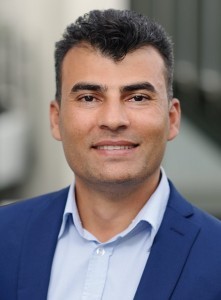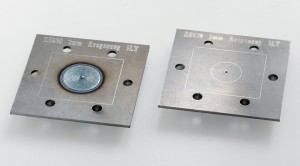The load-bearing capacity of steel and aluminum sheets could be improved in the future. A special form of laser cladding should make this possible. However, industrial partners are still being sought for testing.
Rebar Hama-Saleh promises an innovative field for the project participantsAnew application for additive laser cladding is to be tackled by Automotive Center Südwestfalen GmbH (acs) from Attendorn and the Fraunhofer Institute for Laser Technology ILT from Aachen in the Laval joint project. The focus is on validating a process with which steel and aluminum sheets can be locally reinforced with the help of laser metal deposition. Basic studies have demonstrated an almost three-fold increase in load-bearing capacity - with a minimal increase in weight. Laval is now looking for industrial partners with problems relating to lightweight construction with sheet metal materials, for which solutions are to be developed in the joint project.
In 2017, the Fraunhofer ILT from Aachen launched the AIF project "Material-efficient production of load-adapted sheet metal components with flexible reinforcement zones applied additively by laser" with partners from industry and research, which has now been successfully completed.
The focus was on fundamental studies on the combination of classic sheet metal forming with additive laser cladding.
"We used additive manufacturing to locally reinforce sheet metal components before and after sheet metal forming," explains Rebar Hama-Saleh, a scientist at Fraunhofer ILT. Two applications - a collar pull and the cover of a hydro transducer - have already demonstrated the enormous potential of this hybrid process in the laboratory. By locally thickening the sheet metal with material of the same type, the load-bearing capacity of the collar hoist, for example, could be increased by 264 percent.
A new approach to lightweight construction thanks to targeted sheet metal reinforcement
After treatment, components of a collar hoist showed a 264% increase in load-bearing capacityTheso-called patch increases the total weight by only 4.3%. Simulations and validations confirm the feasibility. This opens up a new form of lightweight construction, as sheet metal can now be dimensioned much thinner. The patches are only used in places where reinforcement is required - for example because a thread has to be cut there. This also allows the acoustic NVH (noise, vibration, harshness) behaviour of the sheet metal to be specifically optimized.
The process is therefore an alternative to welding, soldering or gluing patches, for example, which serve as an effective means of load-adapted sheet thickness distribution. Hama-Saleh: "In contrast to conventional processes, we can use additive manufacturing to apply patches three-dimensionally where the load peak is located."
Powder-based laser cladding can apply reinforcements layer by layer with maximum geometric flexibility, which can be individually adapted in shape. The studies also showed that the complete material closure and the variety of materials ensure maximum adhesion. The surface quality can also be individually adjusted and dissimilar patch materials can be used to counteract corrosion, for example. In particular, the process can be used to produce derivatives and small series, for example in car body construction, without additional expensive tools.
Laval project needs partners
On this basis, acs from Attendorn, an association of industrial companies in the field of lightweight automotive construction, and the Fraunhofer ILT want to launch the Laval research project (locally reinforced semi-finished sheet metal products using additive laser cladding). The aim is to validate the process for steel and aluminum sheets using specific tasks from industry.
The focus of the PNF project (practical research and development) is on working on an innovative subject area for project participants who do not want to tackle a complex task alone.
PNF projects work according to the crowdfunding principle: the project only starts when enough paying partners join in. The fact that acs and Fraunhofer ILT bring the necessary expertise - forming technology on the one hand and laser technology on the other - to the project speaks in favor of participation. We are looking for partners from industry and research who can contribute questions from their practical experience.
 Rebar Hama-Saleh promises an innovative field for the project participantsAnew application for additive laser cladding is to be tackled by Automotive Center Südwestfalen GmbH (acs) from Attendorn and the Fraunhofer Institute for Laser Technology ILT from Aachen in the Laval joint project. The focus is on validating a process with which steel and aluminum sheets can be locally reinforced with the help of laser metal deposition. Basic studies have demonstrated an almost three-fold increase in load-bearing capacity - with a minimal increase in weight. Laval is now looking for industrial partners with problems relating to lightweight construction with sheet metal materials, for which solutions are to be developed in the joint project.
Rebar Hama-Saleh promises an innovative field for the project participantsAnew application for additive laser cladding is to be tackled by Automotive Center Südwestfalen GmbH (acs) from Attendorn and the Fraunhofer Institute for Laser Technology ILT from Aachen in the Laval joint project. The focus is on validating a process with which steel and aluminum sheets can be locally reinforced with the help of laser metal deposition. Basic studies have demonstrated an almost three-fold increase in load-bearing capacity - with a minimal increase in weight. Laval is now looking for industrial partners with problems relating to lightweight construction with sheet metal materials, for which solutions are to be developed in the joint project. After treatment, components of a collar hoist showed a 264% increase in load-bearing capacityTheso-called patch increases the total weight by only 4.3%. Simulations and validations confirm the feasibility. This opens up a new form of lightweight construction, as sheet metal can now be dimensioned much thinner. The patches are only used in places where reinforcement is required - for example because a thread has to be cut there. This also allows the acoustic NVH (noise, vibration, harshness) behaviour of the sheet metal to be specifically optimized.
After treatment, components of a collar hoist showed a 264% increase in load-bearing capacityTheso-called patch increases the total weight by only 4.3%. Simulations and validations confirm the feasibility. This opens up a new form of lightweight construction, as sheet metal can now be dimensioned much thinner. The patches are only used in places where reinforcement is required - for example because a thread has to be cut there. This also allows the acoustic NVH (noise, vibration, harshness) behaviour of the sheet metal to be specifically optimized.

